by Steve da Silva
One of Toronto’s inner suburbs has become a focal point in the ongoing struggle in Venezuela between the Bolivarian transition to socialism and the fascist resistance that has been developing over the last month.
With its face to the bustling city moving past it on Dufferin, just a little south of Lawrence, the quaint little church of San Lorenzo appears as a modest sight to unwitting passersby. But the small church, and its Latin American Community Centre to the rear, are more than simple sites of worship.
Since its establishment in 1997, the San Lorenzo parish has become a beacon for many in the Latin American community who have fled fascist dictatorships and military juntas over the decades from places like Chile, El Salvador, and Guatemala. But its message and ministry amount to more than a salve for the restless migrant soul, more than a home away from home. In the words of the Church’s patron saint, San Lorenzo: “The poor are the treasures of the church.”
That this church actually treasures the poor (as opposed to seeing the poor as a source of its treasures) can be seen in the day-to-day activities that drive the vibrant community organization that has built up around San Lorenzo. Its community centre is home to Radio Voces Latinas 1660 AM, Canada’s only 24-hour Latin American radio station and a key alternative to commercial news, views, and music that dominate the spectrum.
Ambulances on the Caravan of Hope decorated for their trip to El Salvador.
San Lorenzo is also the organizer of the annual “Inti Raymi – Festival of the Sun,” which draws thousands into Christie Pits under the summer sun to to mark the celebration of the summer solstice in the tradition of the Andean region’s Indigenous peoples. The festival routinely raises thousands of dollars for the church’s solidarity missions and charity drives.
Among those programs include fundraising drives for disaster relief in Haiti, Peru, Bolivia, Chile, and Venezuela; as well as the community centre’s “ Caravan of Hope ,” which drives decommissioned ambulances and wheel-trans buses to El Salvador annually.
However, over the years, San Lorenzo and its priest Hernan Astudillo, have courted more controversy than one may think such acts of humanitarianism would invite. When charity becomes solidarity — when one proceeds from charitable handouts to morally and materially supporting struggles to emancipate people from their class oppression — some hearts simply stop bleeding for the poor.
As the old proverb has it, “Give a man a fish and you feed him for a day; teach a man to fish and you feed him for a lifetime.” But what if this man is violently dispossessed of his fishing rod? His family chased away from his lake-side community and into the urban slums? What if the rivers are being poisoned by large corporations?
It is the understanding that such social inequalities are the basis for poverty and suffering that drives San Lorenzo’s and Hernan Astudillo’s theology, which is part of the liberation theology tradition in Latin America that has prioritized the poor and their emancipation and which is seen as reflecting historical Jesus’s lived practice.

This past March 9th, San Lorenzo held a mass to mark the one-year anniversary of the death of former Venezuelan President Hugo Chávez — a tradition in keeping with past ceremonies held by the church for Latin America’s champions of the poor, with masses marking the deaths of various fighters for freedom, from the assassinated Che Guevera to the murdered Archbishop Oscar Romero.
Romero was the Catholic bishop in El Salvador who was assassinated in 1980 in wave of terror that targeted thousands of leftists, including many clerical elements. Romero is also a key figure in Latin America’s liberation theology tradition.
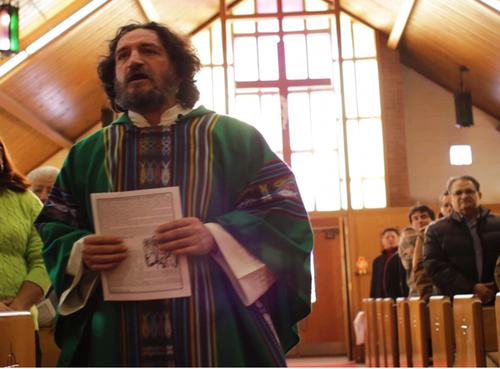 “I did the mass in honour of Hugo Chavez, who I consider with all humility, a very holy man,” priest Hernan Astudillo told BASICS. The result was predictable and sadly not unfamiliar to Astudillo and the church.
“I did the mass in honour of Hugo Chavez, who I consider with all humility, a very holy man,” priest Hernan Astudillo told BASICS. The result was predictable and sadly not unfamiliar to Astudillo and the church.
“I received a fax saying they would ‘eliminate’ me personally… basically, a death threat, they will kill me. We have received death threats over the phone. We have received two messages: One sent by email from an anti-communist organization insulting our people who work on the radio station, saying that they are going to take out our [radio] antenna.”
On March 6, the church received a letter from an organization calling itself “Contracomunistas” in which the Radio Voces Latinas was cited as a target. On March 12, the fax threatening Father Hernan’s life came in.
But the threats are nothing new for Father Hernan: “This reminds me how when 14 years ago I performed a mass for Monsignor Oscar Romero in this same church, I had also received death threat letters because I was holding a mass for a ‘communist bishop’.”
If only this was all just some verbal aggressiveness from the Latin American community’s right wing, the threats could perhaps be dismissed as posturing from disgruntled elements anxious about their oligarchic families and classes losing their grips on power back home. But a history of these threats actually materializing on the Church gives great cause for concern.
In 2006, the antenna of Radio Voces Latinas was discovered to have been shot after having experienced some unknown technical problems for a period of time.
BASICS asked Father Hernan if the threats have ever translated into bodily harm: “I’ve received death threats more than ten times and on two occasions, a group has stolen money from us during our summer festival at Christie Pits park. In September 2008, they even came to my office, hit me, and dislocated my right shoulder. They were trying to instigate me to react violently, but I refused to.”
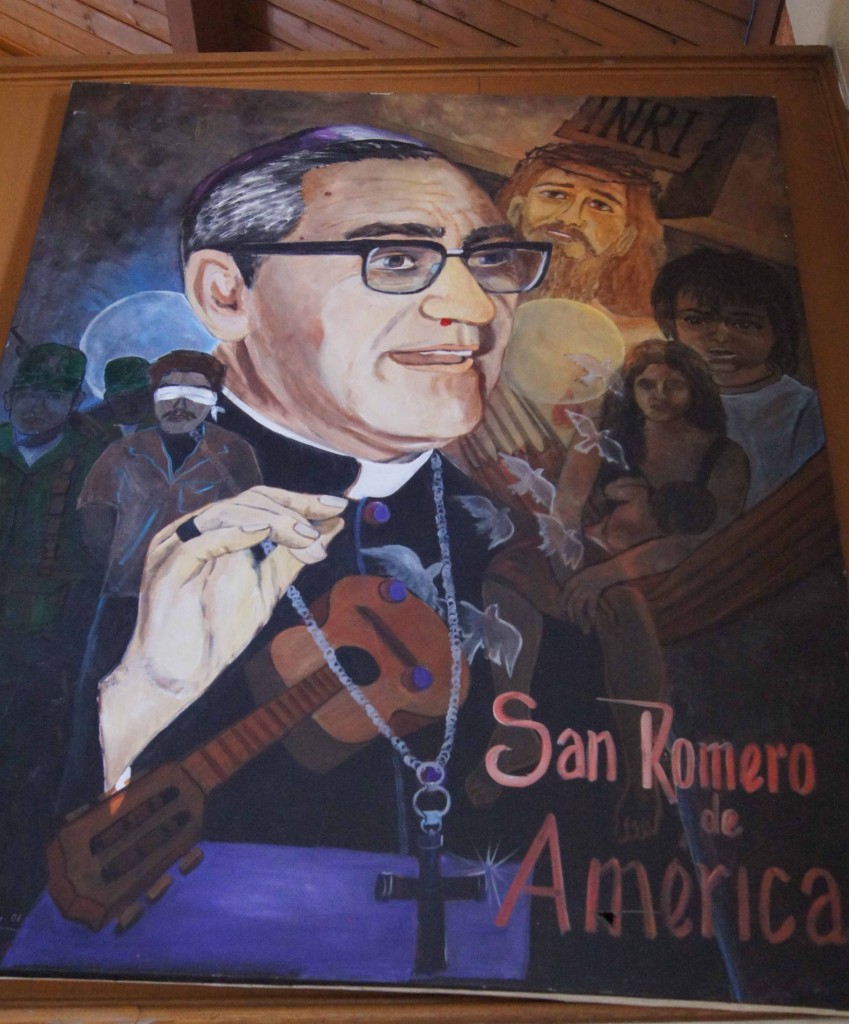
A mural of Oscar Romero in San Lorenzo. Photo Credit: Steve da Silva / BASICS.
Father Hernan drew out the irony and hypocrisy of the attacks on his church’s concern with the poor and their social struggles: “I’ve been meditating over how during this time of Lent [the season of penance and prayer leading into Easter], I might receive even more letters like this [death threats] as I prepare mass for Jesus Christ, because he was really far stronger than Monsignor Oscar Romero and many other martyrs and prophets in the world. His actions, his life, his decisions were always with the poor people.”
BASICS asked Father Hernan if he’s seen any of this opposition or resistance to the church’s pro-poor messaging and its socialist sympathies from within his own parish: “This is from outside. This parish knows what kind of theology we have. We don’t practice the theology of the conquerors. We follow the theology of the historical Jesus Christ, a man who gave his life for equal rights, a man who was fighting the Roman Empire.
“Jesus Christ was not a person who was faking his spirituality in his life. He was a wonderful human being with a pure and transparent identity, to rehumanize the world he was living in at the time in Nazareth and Galilee.”
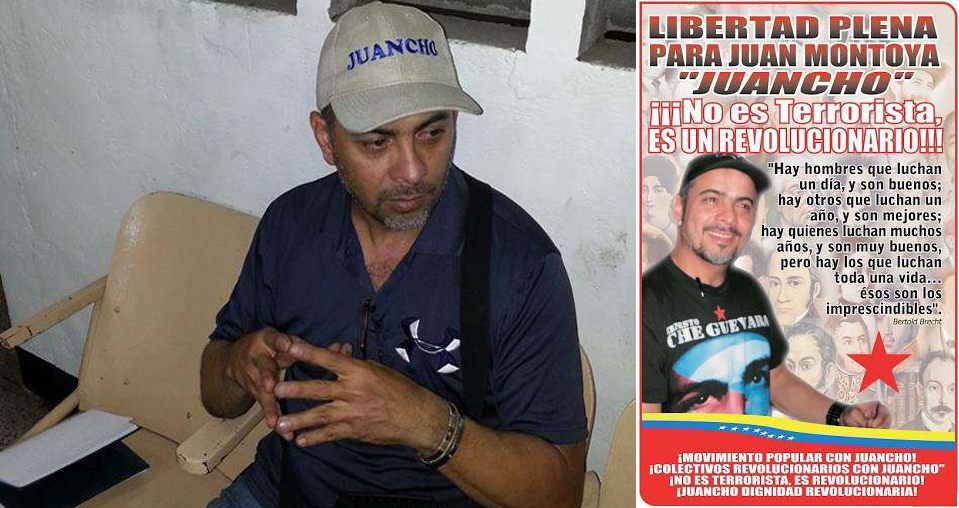
Image to the left of Juan Montoya (Credit: Chris Arsenault/Al Jazeera). Image to the right is a poster for Montoya from some years ago that reads “For the complete freedom of Juan Montoya – “Juancho” – He’s not a terrorist, he’s a revolutionary” at a time Montoya was being persecuted by the Venezuelan government. Indeed, the Bolivarian government has had moments of strained relations with the independent armed organizations in the barrios that long precede Chavez coming to power.
BASICS correspondent and San Lorenzo parishioner Pablo Vivanco was also in attendance at the March 9 mass for Chávez, which brought out a single anti-Chávez protestor.
“One individual brought out a placard in the mass that stated something to the effect of honoring the ‘student martyrs’ in Venezuela,” Vivanco commented.
“Of course, the names he had on there (some of them incorrectly spelled) were of Chavistas and others killed by the violent opposition in Venezuela. One of the names this individual was hailing as a ‘martyr’ was Juan Montoya [killed in mid February], who was actually a prominent member the Tupamaros.”
The Tupamaros is a decades-old leftist guerrilla organization with a strong base in some of Caracas’ poor neighbourhoods that has been supportive but independent of the Venezuelan government.
“So it’s entirely disingenuous to claim Montoya’s death for the opposition cause, and equally dishonest to not acknowledge that the vast majority of people who have been killed in the last month are the result of the opposition and their actions,” a fact of the reality in Venezuela that is being assiduously documented by independent researchers .
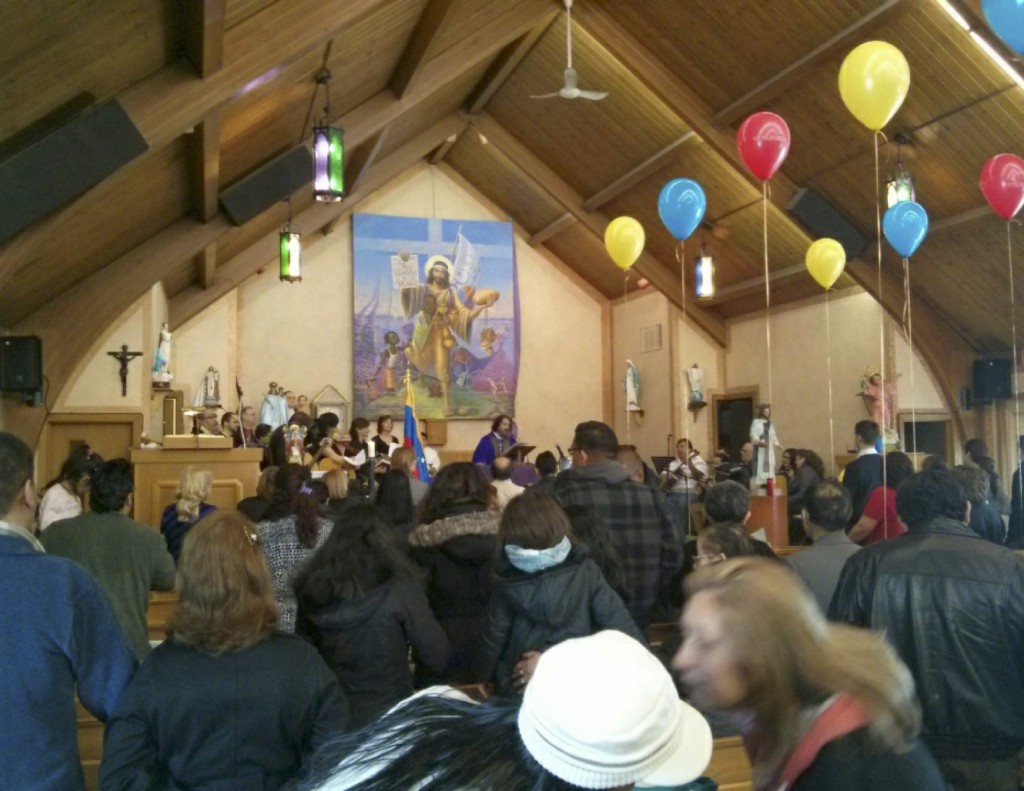
An image from the March 9 mass.
“But the right wing sectors in the community unfortunately do not have this sort of tolerance,” Vivanco elaborated. “This isn’t the first time that threats have been issued against Father Hernan for his principled stances. What’s more concerning is that the violent right wing opposition in Venezuela is killing people and has also attacked media and journalists, so who knows if those allied with the opposition in Venezuela will try something like that here.”
In 2010, Father Hernan Astudillo visited Venezuela to learn about the vast expansion of popular media projects in the country and to deliver the community-generated funds to victims of landslides.
From his own experiences in the country, Father Hernan shared with BASICS his view that: “The opposition in Venezuela is fighting not because they want to help the poor people, but because they want Venezuela’s oil wealth to themselves. They are not fighting because they want to help the poor people, like President Hugo Chavez did. That finally poor people have hope is beautiful.“
The evidence of the threats against San Lorenzo and Hernan Astudillo are now in the hands of Toronto Police Services. BASICS contacted 13 Division’s Criminal Investigations Bureau on the morning of March 19, but the assigned detectives were not available at the time of publication for comment.
With the legitimacy that the Canadian government has given to the violent opposition and the blame for violence that is has misattributed to the Venezuelan government, we shall see if the threats against San Lorenzo will be treated with the same severity that such threats would be met with if they threatened a corporate leader or a Canadian politician. Updates on this investigation will be made here.

The Jesus represented here in a mural at the front of San Lorenzo reflects liberation theology’s view of the historical Jesus of Nazareth, a stark contrast with the Jesus brought by the “the conquerors” Jesus. Photo Credit: Steve da Silva / BASICS
Comments

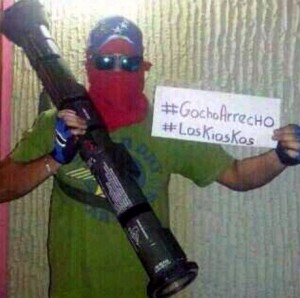

Pingback: (VIDEO) Rightwing Venezuelan figure courted at Scotia Bank Building in Toronto | Hugo Chavez PDF
Pingback: Rightwing Venezuelan figure courted at Scotia Bank Building in Toronto | Hugo Chavez PDF
Pingback: Member of the Venezuelan opposition speaks in Toronto; supporters censor critics | The {Public} Sphere